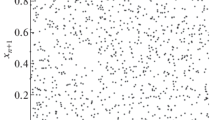Abstract
The nonlinear congruential method for generating uniform pseudorandom numbers has several very promising properties. However, an implementation in multiprecision of these pseudorandom number generators is usually necessary. In the present paper a compound version of the nonlinear congruential method is introduced, which overcomes this disadvantage. It is shown that the generated sequences have very attractive statistical independence properties. The results that are established are essentially best possible and show that the generated pseudorandom numbers model true random numbers very closely. The method of proof relies heavily on a thorough analysis of exponential sums.
Similar content being viewed by others
References
Eichenauer, J., Grothe, H., Lehn, J.: Marsaglia's lattice test and non-linear congruential pseudorandom number generators. Metrika35, 241–250 (1988).
Eichenauer-Herrmann, J.: Equidistribution properties of nonlinear congruential pseudorandom numbers. Metrika40, 333–388 (1993).
Eichenauer-Herrmann, J.: Inversive congruential pseudorandom numbers: a tutorial. Int. Statist. Rev.60, 167–176 (1992).
Kiefer, J.: On large deviations of the empiric d.f. of vector chance variables and a law of the iterated logarithm. Pacific. J. Math.11, 649–660 (1961).
Lidl, R., Niederreiter, H.: Finite Fields. Reading, Mass: Addison-Wesley. 1983.
Niederreiter, H.: Pseudo-random numbers and optimal coefficients. Adv. in Math.26, 99–181 (1977).
Niederreiter, H.: Remarks on nonlinear congruential pseudorandom numbers. Metrika35, 321–328 (1988).
Niederreiter, H.: Statistical independence of nonlinear congruential pseudorandom numbers. Mh. Math.106, 149–159 (1988).
Niederreiter, H.: Recent trends in random number and random vector generation. Ann. Operations Res.31, 323–345 (1991).
Niederreiter, H.: Nonlinear methods for pseudorandom number and vector generation. In: Pflug, G., Dieter, U. (eds.) Simulation and Optimization. Lect. Notes Economics and Math. Systems374, 145–153, Berlin: Springer. 1992.
Niederreiter, H.: Random Number Generation and Quasi-Monte Carlo Methods. Philadelphia: SIAM. 1992.
Niederreiter, H.: Finite fields, pseudorandom numbers, and quasirandom points. In: Mullen, G. L., Shiue, P. J.-S. (eds.) Finite Fields, Coding Theory and Advances in Communications and Computing, pp. 375–394. New York: Dekker. 1992.
Niederreiter, H.: Pseudorandom numbers and quasirandom points. Z. Angew. Math. Mech.73, T648-T652 (1993).
Niederreiter, H.: On a new class of pseudorandom numbers for simulation methods. In: Proc. Workshop on Stochastic Programming (Gosen/Berlin, 1992), (to appear).
Niederreiter, H.: New methods for pseudorandom number and pseudorandom vector generation. In: Proc. 1992 Winter Simulation Conf. (Arlington, Va., 1992). pp. 264–269. Piscataway, N. J.: IEEE Press. 1992.
Wichmann, B. A., Hill, I. D.: An efficient and portable pseudo-random number generator. Appl. Statist.31, 188–190 (1982).




